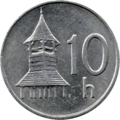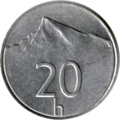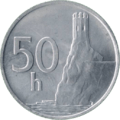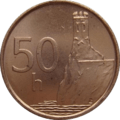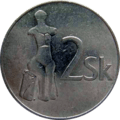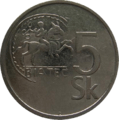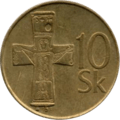Slovak koruna
| Slovak koruna | |||||
|---|---|---|---|---|---|
| slovenská koruna (Slovak) | |||||
| |||||
| ISO 4217 | |||||
| Code | SKK | ||||
| Denominations | |||||
| Subunit | |||||
| 1/100 | halier | ||||
| Plural | The language(s) of this currency belong(s) to the Slavic languages. There is more than one way to construct plural forms. | ||||
| Symbol | Sk | ||||
| halier | h | ||||
| Banknotes | 20 Sk, 50 Sk, 100 Sk, 200 Sk, 500 Sk, 1000 Sk, 5000 Sk | ||||
| Coins | 50 h, 1 Sk, 2 Sk, 5 Sk, 10 Sk | ||||
| Demographics | |||||
| User(s) |
None, previously: | ||||
| Issuance | |||||
| Central bank | National Bank of Slovakia | ||||
| Website |
www | ||||
| Valuation | |||||
| Inflation | 3.5%, December 2008 | ||||
| ERM | |||||
| Since | 28 November 2005 | ||||
| Replaced by €, cash | 1 January 2009 (cash payments possible until 16 January 2009) | ||||
| € = | 30.1260 Sk1 | ||||
| Band | 15% | ||||
|
This infobox shows the latest status before this currency was rendered obsolete.
1 The rate has changed twice. See article for details. | |||||
The Slovak koruna or Slovak crown (Slovak: slovenská koruna, literally meaning Slovak crown) was the currency of Slovakia between 8 February 1993 and 31 December 2008, and could be used for cash payment until 16 January 2009. The ISO 4217 code was SKK and the local abbreviation was Sk. The Slovak crown (koruna) was also the currency of the Nazi-era Slovak Republic between 1939 and 1945. Both korunas were subdivided into 100 haliers (abbreviated as "hal." or simply "h", singular: halier). The abbreviation is placed after the numeric value.
Slovakia switched its currency from the koruna to the euro on 1 January 2009, at a rate of 30.1260 korunas per euro.
In the Slovak language, the nouns "koruna" and "halier" both assume two plural forms. "Koruny"[1] and "haliere" appears after the numbers 2, 3 and 4 and in generic (uncountable) context, with "korún" and "halierov" being used after other numbers. The latter forms also correspond to genitive use in plural.
Koruna of 1939–1945
The koruna (Slovak: koruna slovenská, note the different word ordering from the modern koruna) was the currency of the Slovak Republic from 1939 to 1945. The Slovak koruna replaced the Czechoslovak koruna at par and was replaced by the reconstituted Czechoslovak koruna, again at par. Its abbreviation was Kčs.
Initially, the Slovak koruna was at par with the Bohemian and Moravian koruna, with 10 korunas = 1 Reichsmark. It was devalued, on 1 October 1940, to a rate of 11.62 Slovak korunas to one Reichsmark, while the value of the Bohemian and Moravian currency remained unchanged against the Reichsmark.
Coins
In 1939, coins were introduced in denominations of 10 halierov, 5 and 20 korunas, with 20 and 50 haliers and 1 koruna added in 1940. The 10 and 20 haliers were bronze, the 50 haliers and 1 koruna cupronickel, the 5 korunas nickel and the 20 korunas were silver. In 1942, zinc 5 haliers were introduced and aluminium replaced bronze in the 20 haliers. Aluminium 50 haliers followed in 1943. Silver 10 and 50 korunas were introduced in 1944.
Compared to the pre-war Czechoslovak koruna, the Slovak koruna coins had an additional 50 Ks, the silver content of the 10 and 20 Ks coins was reduced from 700 ‰ to 500 ‰ and all but 5 Ks shrank in physical sizes. The designers were Anton Hám, Andrej Peter, Gejza Angyal, Ladislav Majerský and František Štefunko. Coins were minted in the Kremnica mint.
Banknotes
In 1939, Czechoslovak notes for 100, 500 and 1000 korún were issued with SLOVENSKÝ ŠTÁT overprinted on them for use in Slovakia. That year also saw the introduction of 10 and 20 koruna notes by the government.
Modern koruna
In 1993, the newly independent Slovakia introduced its own koruna, replacing the Czechoslovak koruna at par.
Coins
In 1993, coins were introduced in denominations of 10, 20 and 50 haliers, 1, 2, 5 and 10 korunas. The 10- and 20-halier coins were taken out of circulation on 31 December 2003.In 1996 the 50-halier coin was smaller and instead of aluminium it was made with copper plated steel.
The obverse of the coins feature the coat of arms of Slovakia, with motifs from Slovak history on the reverses.
- 10 halierov (silver-coloured) – Octagonal wooden belfry from Zemplín (early 19th century) = €0.0033
- 20 halierov (silver-coloured) – the Kriváň peak in the High Tatras = €0.0066
- 50 halierov (copper-coloured) – Renaissance polygonal tower of Devín Castle = €0.0166
- 1 koruna (copper-coloured) – Gothic wooden sculpture of the Madonna with child (c. 1500) = €0.0332
- 2 koruny (silver-coloured) – Earthen sculpture of the sitting Venus of Hradok (4th millennium BC) = €0.0664
- 5 korún (silver-coloured) – Reverse of a Celtic coin of Biatec (1st century BC) = €0.166
- 10 korún (copper-coloured) – Bronze cross (11th century A.D.) = €0.332
Coins were exchangeable for euros at the National Bank of Slovakia until January 2, 2014.
Banknotes
At midnight on 31 December 1992, the Czechoslovak Republic bifurcated into the Czech Republic and the Slovak Republic. In 1993, the newly independent Slovakia introduced its own koruna, replacing the Czechoslovak koruna at par. Provisional banknotes were issued in denominations of 20, 50, 100, 500, and 1,000 korún by affixing stamps bearing the coat of arms of Slovakia and the denomination to Czechoslovak banknotes.[2] The main motifs on the obverses of the banknotes represent important people living in the territory of the present Slovakia in various historical eras. On the reverses, these motifs are completed by depicting places where these people lived and were active.
| Denomination | Dimensions (millimetres) |
Value in euros (€) | Image | Main colour | Obverse | Reverse | Remark | ||
|---|---|---|---|---|---|---|---|---|---|
| 20 korún | 128 x 65 | €0.66 | Green | Prince Pribina | Nitra/Neutra Castle | ||||
| 50 korún | 134 x 68 | €1.66 |  |
 |
Blue | Saints Cyril and Methodius | Dražovce church and the first seven letters of the Glagolitic alphabet | ||
| 100 korún | 140 x 71 | €3.32 |  |
Red | Madonna at Levoča church | St. Jacob's church in Levoča/Leutschau and city hall | |||
| 200 korún | 146 x 74 | €6.64 |  |
 |
Turquoise | Anton Bernolák (1762 – 1813), linguist and Catholic priest | Trnava in the 18th century | Introduced in 1995 | |
| 500 korún | 152 x 77 | €16.60 |  |
 |
Brown | Ľudovít Štúr (1815 – 1856), leader of the Slovak national revival | Bratislava Castle and St. Michaels church | ||
| 1000 korún | 158 x 80 | €33.19 |  |
 |
Purple | Andrej Hlinka (1864 – 1938), politician and Catholic priest | Madonna of Liptovké Sliace/Liptau church; St. Andrew's church in Ružomberok | ||
| 5000 korún | 164 x 82 | €165.97 |  |
 |
Orange | Milan Rastislav Štefánik (1880 – 1919), politician and diplomat | Stefanik's grave on Bradlo Hill: Ursa Major constellation | Introduced in 1994 | |
| These images are to scale at 0.7 pixel per millimetre. For table standards, see the banknote specification table. | |||||||||
Slovak banknotes denominated in koruny can be exchanged for euros indefinitely.
Historical exchange rates
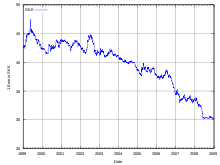
The graph shows the value of the euro in korunas from 1999 to December 2008. As may be seen, the currency strengthened as Slovakia's economy did. The koruna joined the ERM II on 28 November 2005 at the rate of € = 38.4550 Sk with a 15% band.[3][4] On 17 March 2007, this rate was readjusted to 35.4424 Sk with the same band, an 8.5% increase in the value of the koruna.[5] On the same day, 1 euro traded at 33.959 Sk. The central rate of koruna was then adjusted once more on 28 May 2008 to 23.8545 with no change in the band.[6]
See also
Notes
- ↑ CIA - The World Factbook -- Slovakia. 15 May 2007; accessed 19 May 2007.
- ↑ Linzmayer, Owen (2012). "Slovakia". The Banknote Book. San Francisco, CA: www.BanknoteNews.com.
- ↑ "Slovak Koruna Included in the ERM II". National Bank of Slovakia. 2005-11-28. Archived from the original on 2006-10-02. Retrieved 2007-03-17.
- ↑ European Commission. "Exchange Rate Mechanism II (ERM II)". Retrieved 2007-03-17.
- ↑ Radoslav Tomek & Meera Louis (2007-03-17). "Slovakia, EU Raise Koruna's Central Rate After Appreciation". Bloomberg. Retrieved 2007-03-17.
- ↑ Radoslav Tomek & Meera Louis (2008-05-28). "Slovakia Wins EU Approval to Let Koruna Strengthen". Bloomberg. Retrieved 2008-05-29.
References
- Krause, Chester L.; Clifford Mishler (1991). Standard Catalog of World Coins: 1801–1991 (18th ed.). Krause Publications. ISBN 0873411501.
- Pick, Albert (1994). Standard Catalog of World Paper Money: General Issues. Colin R. Bruce II and Neil Shafer (editors) (7th ed.). Krause Publications. ISBN 0-87341-207-9.
- Biľak, M. - Jízdný, M. (1988). Zberatelský katalóg mincí Československa. Československá Numizmatická Spoločnosť, Pobočka Košice.
External links
- ECB: The euro cash changeover in Slovakia (as of 1 January 2009)
- , , (History of the Slovak koruna/crown and its predecessors at the website of the National Bank of Slovakia, parts 1, 2, 3)
- The banknotes of Slovakia (in English) (in German)
| Preceded by: Czechoslovak koruna Reason: independence Ratio: at par |
Currency of Slovakia 1939 – 1945 |
Succeeded by: Czechoslovak koruna Reason: restoration of Czechoslovakia Ratio: ? |
| Preceded by: Czechoslovak koruna Reason: independence Ratio: at par |
Currency of Slovakia 1993 – 2009 |
Succeeded by: Euro Reason: entry into Eurozone Ratio: 1 EUR = 30.1260 SKK |
